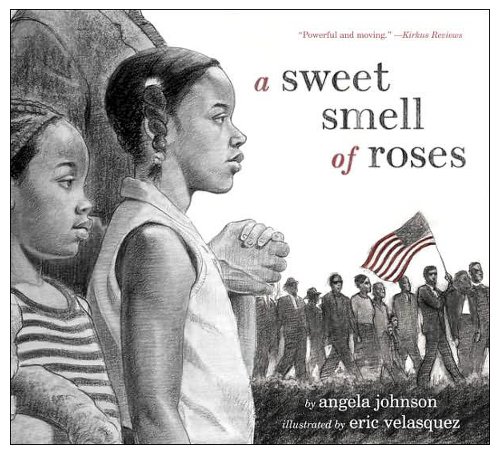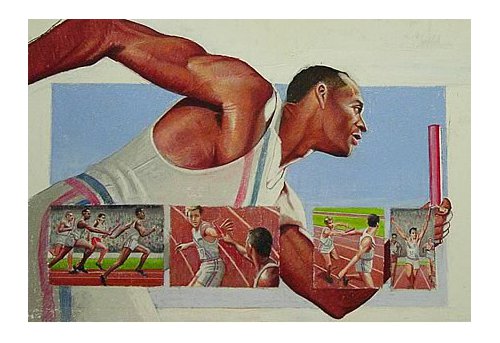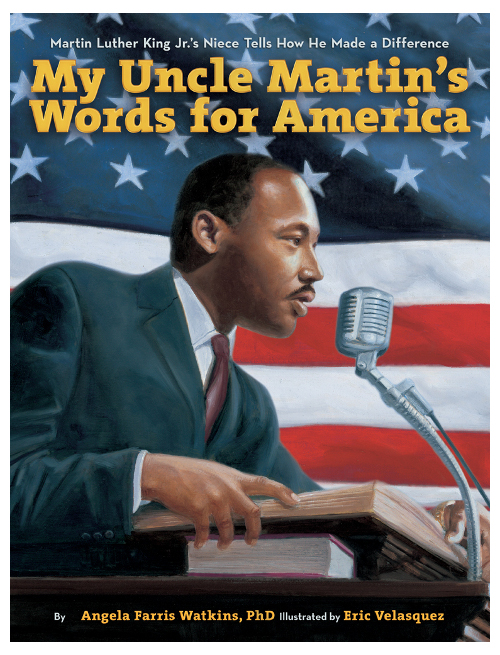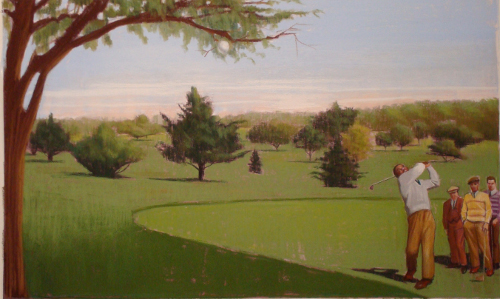Seven Questions Over Breakfast with Eric Velasquez
 June 7th, 2012 by jules
June 7th, 2012 by jules
 “Becoming an artist,” writes author/illustrator Eric Velasquez at his site, “was a natural choice for me. I have never thought of being anything else.” Born to Afro-Puerto Rican parents and growing up in Harlem, Eric developed a love for art, music, and film from his mother, father, and grandmother. In 1983, he earned his degree from the School of Visual Arts and moved on to a career in freelance illustrating.
“Becoming an artist,” writes author/illustrator Eric Velasquez at his site, “was a natural choice for me. I have never thought of being anything else.” Born to Afro-Puerto Rican parents and growing up in Harlem, Eric developed a love for art, music, and film from his mother, father, and grandmother. In 1983, he earned his degree from the School of Visual Arts and moved on to a career in freelance illustrating.
And if you follow children’s lit—particularly if you’re a fan of those illustrators who work in oils, pastels, and realism—it’s likely you know his work. The growing list of book jackets and illustrations he’s done is getting hard to keep up with, to be frank. “To describe illustrator Eric Velasquez as a ‘prolific artist,'” wrote The Brown Bookshelf in 2010, “would be an understatement.” In 1999, he was awarded the Coretta-Scott King/John Steptoe Award for New Talent for the illustrations in his debut picture book, Debbi Chocolate’s The Piano Man, published by Walker Books for Young Readers.

In describing Eric’s paintings for Ann Malaspina’s 2012 picture book biography (Albert Whitman & Company), Touch the Sky: Alice Coachman, Olympic High Jumper (see spreads below in this interview), Publishers Weekly uses the word “majestic.” As you can see in the illustrations below—many from Richard Michelson’s Twice as Good: The Story of William Powell and Clearview, the Only Golf Course Designed, Built, and Owned by an African American, also released this year (Sleeping Bear Press)—Eric’s thickly-painted portraits capture the dignity of their subjects with elegance.
“I don’t often eat breakfast,” he told me, “but I do enjoy a cup of coffee in the morning.” Well, he’s in the right place. I’ll get the basics from him while we get the mugs out. I thank him for visiting.
Jules: Are you an illustrator or author/illustrator?
Eric: Author/Illustrator.


Jules: Can you list your books-to-date?
Eric: Twenty-three books to-date, two of which I wrote and illustrated.


Jules: What is your usual medium, or––if you use a variety—your preferred one?
Eric: Oil on paper.

Jesse Owens: Fastest Man Alive (Walker, 2006)
Jules: If you have illustrated for various age ranges (such as, both picture books and early reader books OR, say, picture books and chapter books), can you briefly discuss the differences, if any, in illustrating for one age group to another?
Eric: When illustrating for a younger reader, the illustrations must be in sync with the text and less suggestive. When illustrating for older readers, the illustrator has more freedom to interpret the text and, at times, adding your own sub-plot to the text by way of location, costume and era.
Mes amis!'”
(Click to enlarge spread.)
To jazz, blues, and rap. / She dances in the hall, / In church . . .”
(Click to enlarge spread.)
Maya dances with grace / And a look of pride on her face.”
(Click to enlarge spread, which is sans text here.)
(Click to enlarge spread.)
Dancing’s fantastic. / Maya loves it all.“
(Click to enlarge spread.)
My Friend Maya Loves to Dance (Abrams, 2010)
Jules: Where are your stompin’ grounds?
Eric: I live in New York.
Jules: Can you briefly tell me about your road to publication?
Eric: I had won second place in a contest held by the RSVP Directory of Illustration. Aside from a little money, a page containing three images of my work was published in the directory and distributed to every publishing house design firm and ad agency in America. I began working shortly after graduating college.
for which Grandma’s Gift (Walker, 2010) was nominated
Jules: Can you please point readers to your web site and/or blog?
Eric: My website is ericvelasquez.com, and my blog is ericvelasquezillustration.blogspot.com. I also have a Facebook fan page and a Twitter account (@ericvelasquezny).
Jules: If you do school visits, tell me what they’re like.
Eric: My school visits consist of a one-hour PowerPoint presentation, chronicling my journey to becoming an illustrator.
(Click to enlarge)
(Click to enlarge)
It was the man he’d first caddied for years before.”
(Click to enlarge)
(Click to enlarge)
7-Imp: If you teach illustration, tell me how that influences your work as an illustrator.
Eric: For the last ten years, I’ve been teaching Book Illustration at FIT (The Fashion Institute of Technology), and what I’ve learned is that one must always walk the walk. Therefore, in regards to my images, I am very particular about my use of perspective and composition, as well as how the figures are articulated with the medium.

I, Matthew Henson: Polar Explorer (Walker, 2007)
Jules: Any new titles/projects you might be working on now that you can tell me about?
Eric: Currently, I am working on a book titled The Price of Freedom. I am very excited about the project.
No place to practice. / No crossbar to raise. …”
(Click to enlarge spread)

Touch the Sky: Alice Coachman, Olympic High Jumper
(Albert Whitman & Company, January 2012)
 Okay, coffee’s on the table, and it’s time to get a bit more detailed with six questions over breakfast. I thank Eric again for visiting 7-Imp.
Okay, coffee’s on the table, and it’s time to get a bit more detailed with six questions over breakfast. I thank Eric again for visiting 7-Imp.
1. Jules: What exactly is your process when you are illustrating a book? You can start wherever you’d like when answering: getting initial ideas, starting to illustrate, or even what it’s like under deadline, etc. Do you outline a great deal of the book before you illustrate or just let your muse lead you on and see where you end up?
Eric: First, I print out the manuscript and read it. Then, I’ll start doodling my initial ideas on the manuscript. From there, I create a set of story boards that represent the story. Next, I create a book dummy, which is a pagination of the pictures and the words. I then present the finished book dummy to the editor and art director for approval.
First she hugged Willie tight. And then she told him,
‘Now you go get me a good whippy switch from one of the willows.'”
— Work-in-progress and final illustration from Twice as Good
(Click each to enlarge)
‘You may as well learn to caddy. That means you can carry my clubs.'”
— Work-in-progress and final illustration (without text) from Twice as Good
(Click each to enlarge)
Once approved, I begin the task of hiring models and photographing them, as well as collecting reference photos for backgrounds and costumes. After all of the references and photographs are collected, I begin the task of doing a full drawing on a large sheet of watercolor paper, which I then tone, once the drawing is complete. Afterwards, I spray it with crystal clear and apply five coats of thinned matte medium. Once dry, I tone the image with an acrylic wash and begin to paint with oil.
But he took a deep breath and walked to the first tee. …”
— Work-in-progress and final illustration (without text) from Twice as Good
(Click each to enlarge)
Sergeant William Powell now, and he had to sail across the ocean to England.”
— Work-in-progress and final illustration from Twice as Good
(Click each to enlarge)
— Work-in-progress and final illustration from Twice as Good
(Click each to enlarge)
2. Jules: Describe your studio or usual work space.
Eric: My studio is the entire second floor of my house.



3. Jules: As a book-lover, it interests me: What books or authors and/or illustrators influenced you as an early reader?
Eric: As an early reader, I was greatly influenced by the books of Brinton Turkle. I also loved comic books, particularly the work of comic artist Neal Adams.
(Click to enlarge and see text)
(Click to enlarge)
Uncle Martin’s voice had power, and so did his words.”
(Click to enlarge and see text)
Uncle Martin’s words of love gave them courage,
and for 381 days African Americans walked or rode in car pools. …”
(Click to enlarge and see text)

4. Jules: If you could have three (living) authors or illustrators—whom you have not yet met—over for coffee or a glass of rich, red wine, whom would you choose?
Eric: I am proud to say that I am friends with most of the illustrators I admire and have probably had a cup of coffee with them already. However, I would gladly trade my signed copy of the The Middle Passage to be able to sit over a cup of coffee with my friend Tom Feelings again.

5. Jules: What is currently in rotation on your iPod or loaded in your CD player? Do you listen to music while you create books?
Eric: Currently, everything by Los Van Van and Alexander Abreu (authentic Cuban bands), as well as everything by Miles Davis. I highly recommend The Complete Jack Johnson Sessions [pictured below]; it’s a real treat. I also have a soft spot for Seal and Prince.

6. 7-Imp: Is there something you wish interviewers would ask you — but never do? Feel free to ask and respond here.
Eric: A) How would you like your work to affect the world of literature?
I would like my work to ultimately make the world of literature more inclusive. At times, it seems I am reading the same book over and over again. I love books that depict a variety of cultures and help me learn about the world around me.
B) What is your least favorite book?

Jules: What is your favorite word?
Eric: “Clarity.”
Jules: What is your least favorite word?
Eric: The phrase “…but, you don’t understand.”
Jules: What turns you on creatively, spiritually or emotionally?
Eric: The truth.
Jules: What turns you off?
Eric: Lies.
Jules: What is your favorite curse word? (optional)
Eric: I believe one must be impeccable with their words.
Jules: What sound or noise do you love?
Eric: The laughter of the people I love.
Jules: What sound or noise do you hate?
Eric: The dentist’s drill.
Jules: What profession other than your own would you like to attempt?
Eric: Film-directing.
Jules: If Heaven exists, what would you like to hear God say when you arrive at the Pearly Gates?
Eric: “Gracias, Maestro!”
More on Twice As Good:
TWICE AS GOOD. Copyright © 2012 by Richard Michelson. Illustration copyright © 2012 Eric Velasquez. Published by Sleeping Bear Press, Ann Arbor, MI. Spreads used with permission of Richard Michelson and Eric Velasquez.
TOUCH THE SKY: ALICE COACHMAN, OLYMPIC HIGH JUMPER. Copyright © 2012 by Ann Malaspina. Illustration copyright © 2012 Eric Velasquez. Published by Albert Whitman & Company, Park Ridge, Illinois. Spreads used with permission of the publisher.
MY UNCLE MARTIN’S WORDS FOR AMERICA: MARTIN LUTHER KING JR.’S NIECE TELLS HOW HE MADE A DIFFERENCE. Copyright © 2011 by Angela Farris Watkins. Illustration copyright © 2011 Eric Velasquez. Published by Abrams, NY. Spreads used with permission of the publisher.
MY FRIEND MAYA LOVES TO DANCE. Copyright © 2010 by Cheryl Willis Hudson. Illustration copyright © 2010 Eric Velasquez. Published by Abrams Books for Young Readers, New York, NY. These images re-posted here from this earlier 7-Imp post.
All other artwork and images used with permission of Eric Velasquez.
The spiffy and slightly sinister gentleman introducing the Pivot Questionnaire is Alfred, © 2009 Matt Phelan.



























Beautiful interview and beautiful artist. I love to see artists’ studios! Thanks for sharing!
What an honor to work with Eric on Twice As Good. He is as great a guy as he is an artist, and that is pretty great as you can see by the illustrations!
Beautiful, beautiful, breathtaking…I need to make a trip to the public library to get some of those titles I have not seen or read yet. Thanks so much to Eric and Jules. A wonderful clear summer day here but greatly enhanced by this.
What a fantastic artist – thank you so much for sharing his work, his lovely smiling face, his studio, his passion with us.
[…] Sources: Illustrator website Illustrator interview : Seven Impossible Things Before Breakfast […]
[…] her gigantic afro and writing her name on everything in crayon. For the first version I created in Eric Velasquez’s picture book class, I used her as a model. Since then, I’ve revised the story multiple times […]
[…] Interview with Eric Velasquez – created by Seven Impossible Things Before Breakfast […]